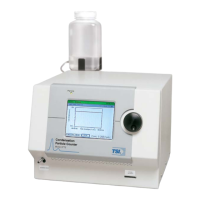4-14 Model 3775 Condensation Particle Counter
change the inlet air pressure. The instrument is designed to operate
with an inlet pressure between 75 and 105 kPa. O: is the
differential pressure across the aerosol flow critical orifice. N: is the
differential pressure across the nozzle. Identification of the orifice
and nozzle are found in the flow schematic
Figure 5-1 in Chapter 5.
Aerosol Flow Rate
Aerosol flow is maintained nominally at 0.3 L/min (300 cubic
centimeters per minute) by the critical flow orifice mounted in the
optics block. A discussion of critical flow is found in Chapter 5,
“
Critical Flow”. Actual flow for each orifice is determined at the
factory and entered into the instrument firmware for use in the
calculation of particle concentration. The actual aerosol flow is very
close to the nominal value of 0.3 L/min.
Laser Current
Laser power is monitored by an internal detector in the laser diode
package. If laser light energy drops below 35 mA, an Error is
indicated.
Liquid Level
Full is indicated if adequate butanol is present in the liquid
reservoir. Liquid level is detected by a heated RTD (Resistance
Temperature Detector) level detector. If the liquid level is low, Not
Full is indicated.
Concentration
Measured particle concentration is displayed in particles per cubic
centimeter (p/cc).
Analog Inputs
Analog Input 1 and 2 display voltages supplied to the BNC
connectors at the back panel of the instrument. These analog data
inputs have a range of 0 to 10 volts. Voltages can come from a
variety of sources at the operator’s discretion. Signals should be
gained up or down so the outputs fall into the 0-to-10-volt window
with maximum resolution. Analog input data can be displayed
together with particle concentration on the front panel LCD display
and saved to the Flash Memory Card during data logging. The
analog input data can also be displayed along with particle
concentration in the Aerosol Instrument Manager
®
software.

